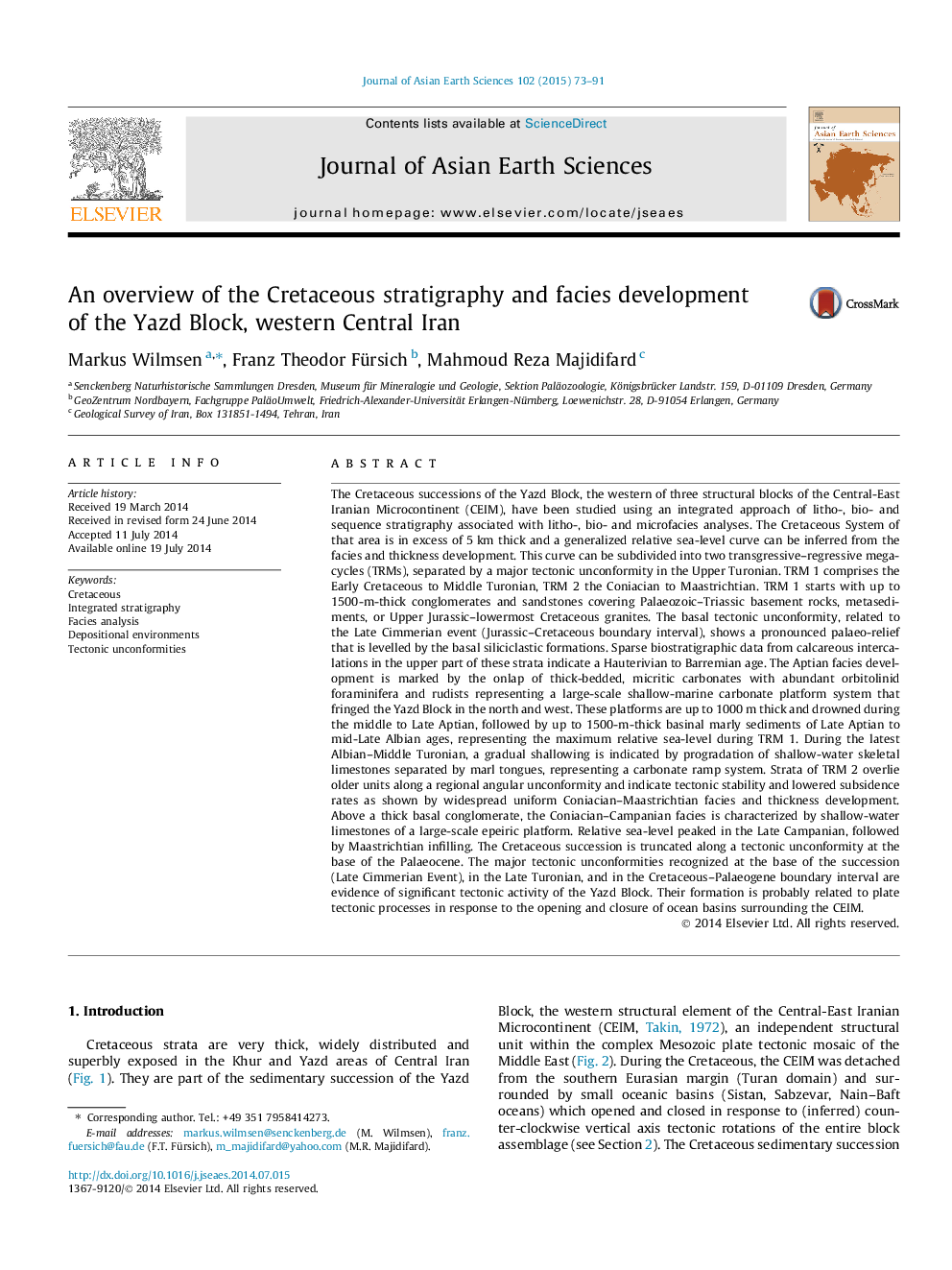| کد مقاله | کد نشریه | سال انتشار | مقاله انگلیسی | نسخه تمام متن |
|---|---|---|---|---|
| 4730411 | 1640367 | 2015 | 19 صفحه PDF | دانلود رایگان |
عنوان انگلیسی مقاله ISI
An overview of the Cretaceous stratigraphy and facies development of the Yazd Block, western Central Iran
ترجمه فارسی عنوان
یک مرور کلی از چینه شناسی کرتاسه و توسعه رخساره بلوک یزد، غرب ایران مرکزی
دانلود مقاله + سفارش ترجمه
دانلود مقاله ISI انگلیسی
رایگان برای ایرانیان
کلمات کلیدی
موضوعات مرتبط
مهندسی و علوم پایه
علوم زمین و سیارات
زمین شناسی
چکیده انگلیسی
The Cretaceous successions of the Yazd Block, the western of three structural blocks of the Central-East Iranian Microcontinent (CEIM), have been studied using an integrated approach of litho-, bio- and sequence stratigraphy associated with litho-, bio- and microfacies analyses. The Cretaceous System of that area is in excess of 5Â km thick and a generalized relative sea-level curve can be inferred from the facies and thickness development. This curve can be subdivided into two transgressive-regressive megacycles (TRMs), separated by a major tectonic unconformity in the Upper Turonian. TRM 1 comprises the Early Cretaceous to Middle Turonian, TRM 2 the Coniacian to Maastrichtian. TRM 1 starts with up to 1500-m-thick conglomerates and sandstones covering Palaeozoic-Triassic basement rocks, metasediments, or Upper Jurassic-lowermost Cretaceous granites. The basal tectonic unconformity, related to the Late Cimmerian event (Jurassic-Cretaceous boundary interval), shows a pronounced palaeo-relief that is levelled by the basal siliciclastic formations. Sparse biostratigraphic data from calcareous intercalations in the upper part of these strata indicate a Hauterivian to Barremian age. The Aptian facies development is marked by the onlap of thick-bedded, micritic carbonates with abundant orbitolinid foraminifera and rudists representing a large-scale shallow-marine carbonate platform system that fringed the Yazd Block in the north and west. These platforms are up to 1000Â m thick and drowned during the middle to Late Aptian, followed by up to 1500-m-thick basinal marly sediments of Late Aptian to mid-Late Albian ages, representing the maximum relative sea-level during TRM 1. During the latest Albian-Middle Turonian, a gradual shallowing is indicated by progradation of shallow-water skeletal limestones separated by marl tongues, representing a carbonate ramp system. Strata of TRM 2 overlie older units along a regional angular unconformity and indicate tectonic stability and lowered subsidence rates as shown by widespread uniform Coniacian-Maastrichtian facies and thickness development. Above a thick basal conglomerate, the Coniacian-Campanian facies is characterized by shallow-water limestones of a large-scale epeiric platform. Relative sea-level peaked in the Late Campanian, followed by Maastrichtian infilling. The Cretaceous succession is truncated along a tectonic unconformity at the base of the Palaeocene. The major tectonic unconformities recognized at the base of the succession (Late Cimmerian Event), in the Late Turonian, and in the Cretaceous-Palaeogene boundary interval are evidence of significant tectonic activity of the Yazd Block. Their formation is probably related to plate tectonic processes in response to the opening and closure of ocean basins surrounding the CEIM.
ناشر
Database: Elsevier - ScienceDirect (ساینس دایرکت)
Journal: Journal of Asian Earth Sciences - Volume 102, 15 April 2015, Pages 73-91
Journal: Journal of Asian Earth Sciences - Volume 102, 15 April 2015, Pages 73-91
نویسندگان
Markus Wilmsen, Franz Theodor Fürsich, Mahmoud Reza Majidifard,
